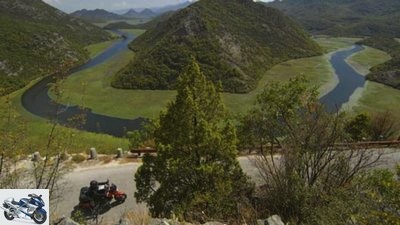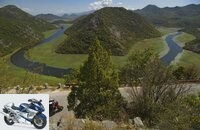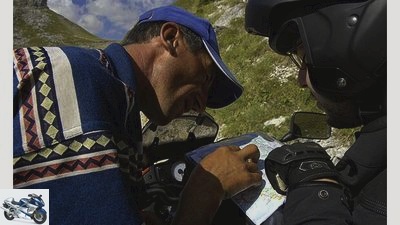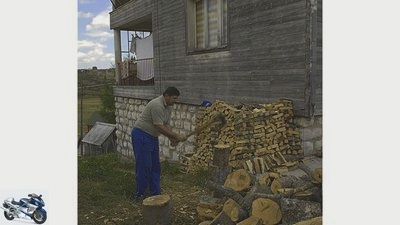Table of contents

Daams
to travel
Montenegro
Montenegro
Phoenix from the ashes
The southernmost fjord, the deepest canyon and one of the last primeval forests in Europe ?? Montenegro holds some records. Since the declaration of independence in 2006, it has also been one of the newest countries in the world and offers fascinating motorcycle routes.
Klaus H. Daams
06/19/2008
“How do you find our country?”, the girl in the flower dress asks the two motorcyclists who moved to Herceg Novi on the turquoise Adriatic Sea in mid-August. Frank and I have just entered Montenegro from Croatia, standing on the promenade. In the midst of all the bikinis and swim shorts, we stand out like the main characters in another episode of “Men in Black”. We cannot yet give the inquisitive lady a well-founded answer, but we rate her question as an indication that the Montenegrins like to look beyond their geographical horizons and actively participate in the fate of their country.
In a referendum on May 21, 2006, the citizens of the former Yugoslav republic of Montenegro decided to break away from Serbia, with which they had formed an association of states since the beginning of 2003. Parliament’s declaration of independence was followed by recognition under international law by all EU members. The small country is now a member of numerous international organizations – and is even considered the latest discovery of the jet set. Little of this can be felt in Herceg Novi. Sooting buses instead of whispering twelve-cylinders, young families instead of Richard Gere or Ralf Schumacher. In the steep streets of the old town sloping down to the sea, a mix of Orient and Baroque, peppered with palm trees, oleanders and agaves, our engines are easily drowned out by the bass from the Citadela bar.
But now out of the city, onto the coastal road along the Boka Kotorska, the Bay of Kotor. It is the mightiest fjord in southern Europe: the arm of the sea juts 30 kilometers inland, the cliffs rise steeply up to almost 1900 meters from the water. In Risan we almost miss the junction towards Grahovo out of sheer amazement.
Buy complete article

Montenegro
Phoenix from the ashes
12 pages) as PDF
€ 2.00
Buy now
In the confusing meandering street we want to allow ourselves a minute’s silence behind a car that is also striving uphill: “Republika CG” is on the number plate reinforcement. “Crna Gora“ is Serbian and means Black Mountain, Montenegro. It is hard to imagine that in Germany, with the exception of the Free State of Bavaria, there is such openly demonstrated national awareness. They can actually be a little proud, or at least consider themselves lucky, the Montenegrins. After the bloody disintegration of the multi-ethnic state of Yugoslavia, their soldiers were also involved in the war in Croatia (1991 to 1995), but apologies have been asked several times for this and even reparations have been agreed. In the Kosovo War (1999) there was an open conflict between the then President of Montenegro, Milocukanovic, and the Serb leader Slobodan Miloševic. It is probably not least thanks to this fact that Montenegro, in contrast to the Serbian capital Belgrade, was largely spared from the NATO bombers and was finally released into independence as a “model boy”, quickly recognized by both the EU and the Russia. Even the Serbs gave their blessings. A development that Kosovo can only dream of. It’s been a tricky story with the Balkans and multiethnic states – and the minute is surely up. Shift down twice.
The Kawasaki Versys is completely in its element, flies skyward on the narrow strip of asphalt that has been patched a thousand times. Even if the course of the route does not necessarily coincide with the map, the lane appears sometimes ancient, sometimes brand new, our pleasure does not affect our enjoyment. On the facade of a ruin littered with bullet holes, a plaque commemorates the expulsion of the fascists in 1944, who found their often invisible masters in Tito’s partisans. Incidentally, there have been no war deaths in Montenegro since the end of the Second World War; the Balkan war was always raging elsewhere.
We have to give up our plan to drive through the mountains via Grahovo. Together with the sun we descend back to Risan, from there on the coastal road past the pretty Perast with its two monastery islands to Kotor. This is the most beautiful city in all of Montenegro, a World Heritage Site and resurrected splendidly from the ruins of the 1979 earthquake.

Daams
Poor of signposts, but rich in driving and landscape experiences.
7.45 p.m., summer in the city, a feeling almost like being in a glamorous place on the Côte d’Azur. Yachts swing in the glittering harbor basin, strollers stroll along the promenade. The old town, which can only be conquered by foot, is surrounded by a mighty fortification, which, like the Great Wall of China, also stretches uphill – and can be appreciated most relaxed by tired warriors from the opposite side of the bay, where we finally find our quarters at Prcanj Find.
“One of the most spectacular mountain slopes”, the travel guide whets the appetite for the serpentine ascent to Lovcen, Kotor’s local mountain, at breakfast. 1000 meters of altitude are to be cracked, as the engines cheer. And the landscape? Mediterranean and alpine at the same time, plus a panoramic view like the Geirangerfjord.
Such impressions can finally be digested in peace and quiet in Cetinje, the former capital of the country. Sunk deep in the cushions of the Caffe Pariz, we order a whole battery of Vodavoda bottles. Sounds like vodka, but it tastes like water. The youth of Montenegro were cast in the neighboring armchairs. Despite chilled music, we defeat our weaker self and tackle the onward journey. But not without a flying visit to the official residence of the president, which is guarded by two stoic soldiers and a bull-necked gorilla.
Anyone interested in human physiognomy will find a perfect field of research on the Adriatic. However, we want to continue. It takes less than three hours from Budva via Bar to Ulcinj, past the Sveti Stefan peninsula, which has mutated from a fishing village into a luxury complex and can only be reached for an entrance fee.
In Ulcinj, known for the longest sandy beaches of the Eastern Adriatic (13 kilometers) and the highest Albanian population in Montenegro (90 percent), turn left towards Vladimir – and you immerse yourself in another world: numerous minarets reach into the evening sky. We are now shortly before the Albanian border, driving through the southern foothills of the Dinaric Ridge, which here reminds of the rugged chains of the Auvergne. A sharp left on a knoll – and a silent wow! In front of us lies the Skadar Lake, the largest inland lake in the Balkans and extremely rich in species.
This is followed by 60 winding kilometers through the night. The end of the ghost is only in Virpazar, where the floodlights of a football field greet us back in civilization. A little later in the hotel restaurant Pelikan even a fish called bleak swims in my beer-filled stomach.
“Come on in,” asks us the next day in Rijeka Crnojevica, a nest northwest of Virpazar, a guy from the German wrestling league into his cool, freshly renovated office. Sascha was born in Mannheim and returned to his homeland in Montenegro after training as a draftsman. There he now runs a betting shop where people can bet their mice on football clubs like “Shalke”. When I read “Dortmund – Duizburg 1: 3“ on the bulletin board, it is time to do a few kilometers and forget the lost game.

Daams
In Zabljak, poverty is mixed with effective do-it-yourself awareness – and not just when splitting firewood.
The destination is the mountainous north with the Durmitor National Park and 48 two-thousand-meter peaks, the highest of which is the Bobotov Kuk (2522 meters). We roam the capital Podgorica, greet the holy Ostrog monastery, which is clinging to the mountain. Our path leads rather stubbornly straight to Nikšic, then to Šavnik. The sun gently caresses the light grass, a three-cheesecake carefully aims his air rifle at a plum on the tree. The last rays of daylight hit the retina exactly between two mountains.
In Žabljak, the highest town (1450 meters) and winter sports center of Montenegro, we can only find one badly shabby place to stay. Somehow fitting that two hours later Laura Brannigan’s “Self Control” is booming out of the speakers at the trendy meeting place Cudna Šuma.
Almost outstanding, almost a poem, the next day the road from Virak to Trsa. At first it starts quite gravelly, knocks on the engine guard of the 650s every now and then, then dusts up the Sedlo pass (1908 meters) – and finally slips, enduro riders screaming in vain “Stop!” In fresh gray asphalt. As proud as Oskar, a construction troika poses for the group photo. They greet us almost like old acquaintances when we pass by for the second time after we turned back in front of Trsa. The third time, everything is sure to be posh, gravel will only be a memory.
The Tara Gorge is practically the petrified memory of Mother Earth. The river has nibbled its way through the Durmitor Mountains 1,300 meters deep. The best way to marvel at the great Tara on dry feet is from the bridge at Durðevica. And where are you going through the Biogradska Gora National Park to Beranec One of the last three primeval forests in Europe cannot be ignored. The gas station attendant in Mojkovac strongly advises against the route via Kuricuce: “very bad.” A kingdom for camping equipment and a sack full of time.
At an ice cream parlor, a curious boy comes up to us and points to the speedometer. Around 200 – that’s still easy, then the conversation comes to a standstill. “Do you speak English?” He doesn’t. “Montenegrin?” Indignant shaking of the head: Serbian! History is no picnic, the world is full of faux pas. Even scholars argue whether Montenegrin is a separate language, more of a Serbo-Croatian or Serbian dialect. Whatever the case, at least linguistically there are few problems between the residents of the former Yugoslavia, they get along as well as, let’s say, Swabians and Baden residents. “Good luck”. We set off for the national park.
About five kilometers south of Mojkovac, a road branches off to the left from the route to Kolašin to Biogradska Gora. We try our luck. A log cabin with a ranger. Yes, yes, this means to us, back there between the trees it goes on. That’s right, but about stick and stone. 45 fantastic kilometers of country roads from Kolašin to Andrijevica follow, then we end up in Plav, a small town just before Kosovo, where everything seems to be possible except accommodation. The friendly question “Hey, are you from Offebach?”, Tears us out of the unpromising travel guide reading (“Unfortunately you are looking for tourist structures in vain”).
A few minutes later we follow our saving angel Smako back through the village to the Restoran Lovac. A short negotiation with Dragana, the spirited queen of the shop, and everything will be fine, a room is occupied and the stove is even turned on again. Smako is Albanian and Muslim. Oriented towards the west, he doesn’t believe in headscarves and remarks: “My wife can even walk without a bump.”
At 5 o’clock the muezzin wakes us up. An elderly gentleman is already sitting in the dining room. Salih Djombali? is 75 and has traveled widely in life. He was born in Plav and worked as a house painter in New York City for 35 years. Now, as a pensioner, he commutes: two months in Montenegro, then back to America. Salih has a very bad opinion of George W. Bush. The biography of our frank conversation partner is not an isolated case, the exodus is omnipresent and has by no means stopped. No job, no money – those who are young move away. As if to mockery, but perhaps also as a bearer of hope, the landscape is still dotted with new, often uninhabited homes.
Plav’s showpiece is Lake Plav, a jewel whose value nobody seems to appreciate. The shore road leads to Gusinje, right into a world that we like to call oriental. Minarets like cruise missiles, street cafes like everywhere in summer, two begging girls like in front of Cologne Cathedral. And everywhere helpful people, every second of whom speaks German.
On the road to the Serbian border near Rožaje we come across a decommissioned drinks truck from Sindelfingen with the label “inexpensive-efficient-reliable”. In the end, Montenegro has a bang in store: the road blasted into the rock leads through a really grandiose gorge. Only mountains of rubbish burning apocalyptically cloud the view – almost as beautiful as in Italy. And possibly the stuff without which there would be no phoenix.
Info Montenegro
Those who only visit the beaches of the Adriatic in Montenegro are missing out on something: the hinterland with mountains up to 2500 meters high, ideal for motorcyclists who like to explore. On secondary roads that are not (yet) continuously asphalted, it is advisable to use a travel enduro bike ?? but at least without a gravel allergy.
ARRIVAL 1200 kilometers, almost exclusively on motorways, from Munich via Salzburg, Zagreb, Split and Dubrovnik to the Croatian-Montenegrin border and the Bay of Kotor. 300 kilometers shorter – but not necessarily faster – is the route that first leads via the Felbertauern tunnel and Trieste to Rijeka and from there along the Adriatic Sea to the height of Zadar; from there you continue on the motorway towards Split and Montenegro. A tire-saving consideration, especially for North Germans: the car train to Villach / A, Bozen or Verona in Italy (www.autozug.de). An alternative to the land route is the ferry passage from Ancona in Italy to Bar in Montenegro (www.montenegrolines.net).
PRACTICAL INFORMATION A passport and green insurance card are required to enter the country. The means of payment in Montenegro is the euro. There are enough ATMs and petrol stations. Since excursions into the undeveloped hinterland tend to be protracted, replenishing supplies early – for man and machine – can have a calming effect. The months before and after the midsummer heat are recommended as the best travel time. Until October, pleasant water temperatures allow bathing in the Mediterranean Sea and in the sheltered bay of Kotor. Communication with the locals often works very well, a surprising number of whom speak German or English. Don’t be afraid of the occasional Cyrillic signposts: Usually you will find the usual Latin characters – and always ways back.
ACCOMMODATION Even in Tito’s time, the Montenegrin coast with its Mediterranean climate – 200 days of sunshine per year – was considered an inexpensive alternative to Italy. A correspondingly diverse range of hotels and private rooms awaits travelers between the Bay of Kotor and Ulcinj on the Albanian border. In the interior of the country, on the other hand, tourism is indeed a beacon of hope for economic development, but the bed capacity is currently not particularly high. The search for a quarter can thus become an integral and exciting part of the tour. And even if the sanitary standard does not always correspond to Western European norms: Travel should create more than just the foam under a warm shower. Recommended accommodations on the route described are: Hotel Pelikan, 81305 Virpazar, phone 00381 / (0) 81711107 or 160, fax 00381 / (0) 81711011; Hotel Javor, Bozidara Zugica 8, 84220 Žabljak, phone 00381 / (0) 89361337, fax 00381 / (0) 89361307, www.durmitor.org.yu.
LITERATURE Three authors report in their travel guides dedicated and competent about the small country between the Adriatic Sea and the Durmitor massif, albeit in a very different way: Achim Wiegand in “Montenegro” from Michael Muller Verlag for 15.90 euros, Werner Lips in “Montenegro, Crna Gora” from Reise-Know-How-Verlag for 14.90 euros and Marko Plešnik in “Discover Montenegro” from Trescher’s “Reisen” series for 14.95 euros. Compact alternative: “Montenegro” by Marco Polo for 8.95 euros. The Shell country map “Croatia, Bosnia-Herzegovina, Serbia and Montenegro, Macedonia, Albania” on a scale of 1: 750,000 for 7.50 euros is suitable as a road map for the journey and (conditionally) the destination area. Naturally, “Serbia-Montenegro” of travel know-how on a scale of 1: 400,000 for 8.90 euros is more detailed. The maps available at Montenegrin petrol stations promise even greater accuracy; However, despite the scale of 1: 200000 or 1: 235000, they are not entirely free of errors.
ADDRESSES Information in German is available from www.visit-montenegro.org and www.europa-auf-einen-blick.de; in English www.montenegro.com, www.montenegro-info.com, www.discover-montenegro.com and www.visit-montenegro.com.
Time required: four days
Distance covered: 970 kilometers
Related articles
-
On the way: Montenegro – Balkans
Hess, Schmitz to travel On the way: Montenegro – Balkans On the way: Montenegro – Balkans Out and about in Montenegro: the call of the black mountains…
-
to travel Baltic states Baltic states Different than expected Beaches like on the Mediterranean, cappuccino like in Italy and magnificent buildings that…
-
to travel resin resin The witches ask for a dance Black Forest, Bavarian Forest, the Alps: Southern Germany’s motorcyclists can draw on the full. In…
-
Schroder to travel Germany tour Germany tour 1000 new ways The Rhine and Moselle are more unknown to me than the Amazon and Nile, and I’ve been to the…
-
to travel Mexico Mexico Change of course What to do when a hard winter suddenly arrives in the land of deserts, beaches and volcanoes? Michael Schroder…
-
Jorg Lohse 43 pictures Jorg Lohse 1/43 … and into the kilometer-wide river bed of the Kali Gandaki. Jorg Lohse 2/43 One-a-pit stop at Ramesh (left) and…
-
to travel Nepal Nepal Once limit value and back With a 500 Enfield to the eight-thousanders on earth. A journey between wooden sheds and pagoda temples…
-
to travel South America ?? Antarctic South America ?? Antarctic 42 degrees of latitude On two enduros through the Andes ?? from the Chilean Atacama…
-
Motorcycle tour through Albania: it remains an adventure
Tummescheit to travel Motorcycle tour through Albania: it remains an adventure Motorcycle tour through Albania It remains an adventure Albania welcomes…
-
to travel On the way Croatia On the way Croatia Mission island hopping Few countries are as rich in islands as Croatia: there are 1185 islands, only 67…